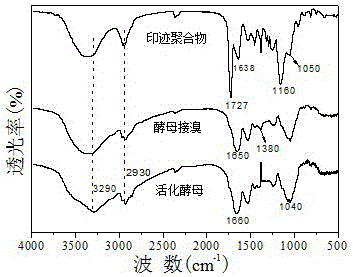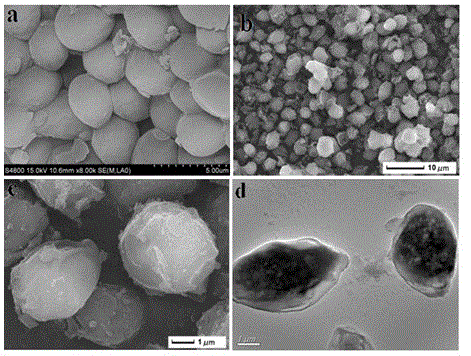A kind of preparation method of adsorbent for selective separation of ciprofloxacin in water environment
A technology for ciprofloxacin and water separation, applied in chemical instruments and methods, other chemical processes, etc., can solve the problem of deep embedding of active sites, poor adsorption-desorption kinetics, mass transfer and charge transfer Slow kinetic rate and other problems, to achieve the effect of reducing non-specific adsorption, fast adsorption kinetic properties, and polymer recognition performance
- Summary
- Abstract
- Description
- Claims
- Application Information
AI Technical Summary
Problems solved by technology
Method used
Image
Examples
Embodiment 1
[0043] (1) Preparation of yeast-brominated composite material
[0044] Disperse 2g of activated yeast in 20mL of dichloromethane, then add 2mL of triethylamine, ice-bath for 10min, pass through N 2 After deoxygenation, 1 mL of 2-bromoisobutyryl bromide was added dropwise, and reacted at room temperature for 8 h. The reaction product was first washed three times with dichloromethane, then washed three times with absolute ethanol, and finally washed at 50 o C in a vacuum oven for 12 h.
[0045] (2) Preparation of ciprofloxacin surface imprinted polymers (MIPs)
[0046] Add 0.5 g of Tween-20 and 25 mL of distilled water into a 100 mL three-neck flask, ultrasonicate for 2 min, and then stir until no bubbles are generated. Then, 0.125 mol of ciprofloxacin, 0.5 mol of methacrylic acid, 0.5 mol of hydroxyethyl methacrylate, 3 mol of ethylene glycol di(methacrylate) ester and 0.25 g of yeast-brominated composite material were added to the emulsion system. The mixture was sonicated...
Embodiment 2
[0054] (1) Preparation of yeast-brominated composite material
[0055] Disperse 2.5g of activated yeast in 50mL of dichloromethane, then add 3mL of triethylamine, ice-bath for 20min, pass N 2 After deoxygenation, 3 mL of 2-bromoisobutyryl bromide was added dropwise, and reacted at room temperature for 10 h. The reaction product was first washed three times with dichloromethane, then washed three times with absolute ethanol, and finally washed at 50 o C in a vacuum oven for 12 h.
[0056] (2) Preparation of ciprofloxacin surface imprinted polymers (MIPs)
[0057] Add 0.6g of Tween-20 and 36mL of distilled water into a 100mL three-neck flask, sonicate for 5min, and then stir until no bubbles are generated. Then add 0.2mol ciprofloxacin, 0.6mol methacrylic acid, 0.6mol hydroxyethyl methacrylate, 4.8mol ethylene glycol di(methacrylate) ester and 0.25g yeast bromine composite material to the above emulsion system . The mixture was sonicated for 10 min to obtain a pre-polymeriz...
Embodiment 3
[0065] (1) Preparation of yeast-brominated composite material
[0066] Disperse 3g of activated yeast in 75mL of dichloromethane, then add 4mL of triethylamine, ice-bath for 40min, pass through N 2 After deoxygenation, 8 mL of 2-bromoisobutyryl bromide was added dropwise, and reacted at room temperature for 15 h. The reaction product was first washed three times with dichloromethane, then washed three times with absolute ethanol, and finally washed at 50 o C in a vacuum oven for 12 h.
[0067] (2) Preparation of ciprofloxacin surface imprinted polymers (MIPs)
[0068] Add 0.8g of Tween-20 and 52mL of distilled water into a 100mL three-neck flask, sonicate for 10min, and then stir until no bubbles are generated. Then, 0.25 mol of ciprofloxacin, 1 mol of methacrylic acid, 1 mol of hydroxyethyl methacrylate, 10 mol of ethylene glycol di(methacrylate) ester and 0.25 g of yeast-brominated composite material were added to the emulsion system. The mixture was sonicated for 10 min...
PUM
| Property | Measurement | Unit |
|---|---|---|
| adsorption capacity | aaaaa | aaaaa |
| adsorption capacity | aaaaa | aaaaa |
| adsorption capacity | aaaaa | aaaaa |
Abstract
Description
Claims
Application Information
 Login to View More
Login to View More - R&D
- Intellectual Property
- Life Sciences
- Materials
- Tech Scout
- Unparalleled Data Quality
- Higher Quality Content
- 60% Fewer Hallucinations
Browse by: Latest US Patents, China's latest patents, Technical Efficacy Thesaurus, Application Domain, Technology Topic, Popular Technical Reports.
© 2025 PatSnap. All rights reserved.Legal|Privacy policy|Modern Slavery Act Transparency Statement|Sitemap|About US| Contact US: help@patsnap.com



